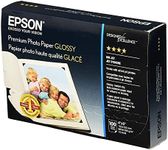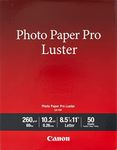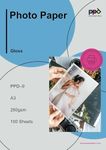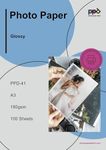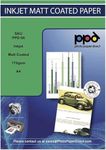Buying Guide for the Best Inkjet Photo Papers
Choosing the right inkjet photo paper is crucial for achieving high-quality prints that meet your needs. The type of paper you select can affect the color accuracy, sharpness, and longevity of your photos. To make an informed decision, you need to understand the key specifications and how they align with your printing requirements. Here are the main factors to consider when selecting inkjet photo paper.Paper FinishPaper finish refers to the surface texture of the photo paper, which can be glossy, matte, or semi-gloss. Glossy paper has a shiny finish that enhances color vibrancy and sharpness, making it ideal for photos with rich colors and high contrast. Matte paper has a non-reflective surface that reduces glare and fingerprints, suitable for black-and-white photos or images with subtle tones. Semi-gloss offers a balance between glossy and matte, providing good color reproduction with less glare. Choose the finish based on the type of photos you print and your preference for surface texture.
Paper WeightPaper weight is measured in grams per square meter (gsm) and indicates the thickness and sturdiness of the paper. Heavier paper (200 gsm and above) feels more substantial and professional, making it suitable for high-quality prints and framing. Medium-weight paper (150-200 gsm) is versatile for everyday photo printing and albums. Lighter paper (below 150 gsm) is more economical and suitable for casual prints or drafts. Consider the intended use of your prints to determine the appropriate paper weight.
BrightnessBrightness measures the reflectivity of the paper and affects how vivid and crisp your photos appear. It is usually rated on a scale from 1 to 100, with higher numbers indicating brighter paper. High-brightness paper (90 and above) enhances color contrast and detail, making it ideal for vibrant, high-resolution images. Lower brightness paper (below 90) can give a softer, more subdued look, which might be preferred for artistic or vintage-style photos. Choose the brightness level based on the visual impact you want for your prints.
OpacityOpacity refers to the paper's ability to prevent light from passing through, which is important for double-sided printing. High-opacity paper (close to 100%) ensures that images and text do not show through to the other side, making it ideal for photo books and brochures. Lower opacity paper may be more translucent, which can be acceptable for single-sided prints. Consider whether you need to print on both sides of the paper when evaluating opacity.
Drying TimeDrying time is the duration it takes for the ink to fully set on the paper. Faster drying times reduce the risk of smudging and allow for quicker handling of prints. This is particularly important for high-volume printing or when prints need to be used immediately. Some papers are designed to absorb ink quickly, while others may take longer. If you need to handle prints soon after printing, look for paper with a fast drying time.
Archival QualityArchival quality refers to the paper's ability to resist fading and deterioration over time. Papers labeled as archival or acid-free are designed to last for decades without significant degradation, making them ideal for preserving important photos and documents. If you want your prints to maintain their quality for a long time, especially for professional portfolios or family heirlooms, choose archival-quality paper.





